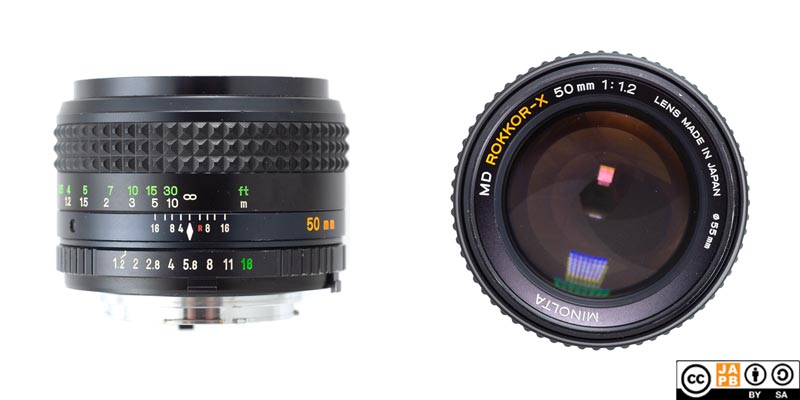Pekka Buttler, 01/2023

Specifications
The table below summarizes the lens’ key specifications (Measurements based on pictured sample):
| Brand: | Minolta | Lens name | MD Rokkor(-X) 50mm 1:1.2 |
| Focal length(s) 1 | 50 mm | Angle-of-view 2 | 46,8 ° |
| Maximum Aperture | f/1.2 | In Production | 1978–1981 |
| Lens mounts | Minolta SR | Subfamily (if applicable) | MD (II) |
| Length 3 | 46,1 mm | Diameter 4 | 65,6 mm |
| Filter ring diameter | 55 mm | Weight | 316 grams |
| Lens element count | 7 | Lens group count | 6 |
| Aperture blades (S/R/C) 5 | 6 S | Focus throw | 180 ° |
| Minimum focusing distance | 45 cms | Maximum magnification | 1:6,9 |
| Has manual aperture ring | YES | Has Manual focus ring | YES |
| Aperture mechanism type | Automatic | Aperture click stops 6 | 1.2-2•2.8•4•5.6•8•11-16 |
Further notes:
• From the introduction if the Minolta SR system until 1973, Minolta’s choice focal length for standard lenses was 55–58 mm – 58 for the fast fifty (f/1.4) and superfast fifty (f/1.2) and 55 for the nifty fifty (f/1.7–f/2).
• Also, Minolta would typically at the same time offer both a faster nifty fifty (typically f/1.7–f/1.8) and a slower nifty fifty (f/1.9–f/2)
• Starting in 1973, Minolta converted all its standard lenses to a 50 mm focal length, and cemented the maximum apertures of these in a four-tier structure that stayed unchanged throughout the remaining life of the SR system: f/1.2 – f/1.4 – f/1.7 – f/2.
• This lens comes from the first generation of Minolta 50 mm superfast fifties.
• The ROKKOR-X -name (on the lens’ name ring, in orange) indicates that this lens was originally sold on the North-American market.
• The original Minolta 55 mm thread lens hood might be hard to come by, but most 55 mm thread standard lens hoods should work.
Versions
The table below shows the genealogy of all Minolta superfast fifties:
| Name (on lens) | Variant & Generation | years | focal length | max. aperture | min. aperture | elements | groups | filter thread | weight |
| MC ROKKOR-PG | MC I | 1968–1970 | 58 | f/1.2 | f/16 | 7 | 5 | 55 | 455 |
| MC ROKKOR-PG | MC II | 1970–1973 | 58 | f/1.2 | f/16 | 7 | 5 | 55 | 455 |
| MC ROKKOR(-X)-PG | MC X | 1973–1978 | 58 | f/1.2 | f/16 | 7 | 5 | 55 | 478 |
| MD ROKKOR(-X) | MD II | 1978–1981 | 50 | f/1.2 | f/16 | 7 | 6 | 55 | 315 |
| MD | MD III | 1981–≈1995 | 50 | f/1.2 | f/16 | 7 | 6 | 55 | 310 |
Adapting
This lens cannot be used natively on any current SLR or dSLRs. To use it in its native environment, you will need a Minolta SR (SR/MC/MD/X-600) film camera. Luckily these are quite easy to find. To use the lens’ full designed capabilities, a Minolta MD-compatible body (any Minolta SR body launched after 1977) is most recommended..
Thanks to being a fully manual lens (manual aperture, manual focus), the lens can be adapted to all mirrorless cameras using a suitable adapter. Moreover, a simple ‘dumb adapter’ will do the job perfectly. Thanks to the popularity of the Minolta SR mount, the availability of adapters to all mirrorless mounts can be taken for granted, on the other hand, specialist adapters (speed boosters, helicoid adapters, tilt/shift adapters) are not available for all mirrorless mounts, but daisy-chaining adapters (e.g. Minolta SR -> Canon EF; Canon EF –> mirrorless) can offer a work-around.
Using Minolta SR mount lenses on dSLRs is also be an option, but it is not trouble-free due to that the Minolta SR mount’s flange focal distance is shorter than that of any dSLR mount (technically with the exception of Olympus’ four thirds mount). Hence, any attempt at adapting Minolta SR lenses must rely on an adapter that uses corrective optics to allow infinity focus. However, such adapters are readily available.
History of Minolta
Minolta exited the camera business in 2006 and sold its remaining photographic assets to Sony. The 50 years before that ignominious date tell a very different story: one of a Japanese optics and innovation powerhouse that has interesting links to Germany – not Nazi Germany, but both pre WWII Germany as well as postwar West Germany. Read more in the Minolta company profile.
Footnotes
- Focal length is (unless stated otherwise) given in absolute terms, and not in Full-frame equivalent. For an understanding of whether the lens is wide/tele, see ‘Angle-of-view’. ↩︎
- Picture angle is given in degrees (based on manufacturers’ specs) and concerns the diagonal picture angle. Rule of thumb:
> 90 ° ==> Ultra-wide-angle
70–90 ° ==> Wide-angle
50–70 ° ==> Moderate wide-angle
40–50 ° ==> ‘Standard’ or ‘normal’ lens
20–40 ° ==> Short tele lens
10-20 ° ==> Tele lens
5-10 ° ==> Long tele lens
< 5 ° ==> Ultra-tele lens ↩︎ - Length is given from the mount flange to the front of lens at infinity. ↩︎
- Diameter excludes protrusions such as rabbit ears or stop-down levers. ↩︎
- S=straight; R=rounded; C=(almost)circular at all apertures. ↩︎
- Numbers equal aperture values on aperture ring; • intermediate click; – no intermediate click. ↩︎